When I first saw Pyrgos in 2014 it was late afternoon through swirling fog rolling up 700-foot-high cliffs. The mist hugged the low flat scrub land of this dry island and surrounded the base of the hill upon which Pyrgos is built. The white village floated in a mist as mysterious as the legends of Santorini itself.
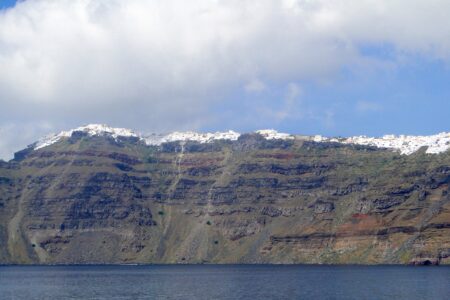
Approaching Santorini by ship a visitor is struck by the sheer size and beauty of its cliffs with towns towering hundreds of feet above the sea. On top is a dry volcanic landscape of low, wind-blown vegetation. The hot daytime temperatures shift to cool as dusk settles over the island.
The rocky volcanic soil absorbs daytime heat and, surrounded by the Aegean Sea, the humidity level rises considerably. At dusk the humidity condenses, and a breeze lifts it up the cliffs creating fog-like conditions. Despite an average annual rainfall of only a few inches, this fog waters the plant life overnight. “The humidity and mist keep the island from being a desert,” says Stela Kasiola, marketing manager for Santo Wines and its Union of Santorini Cooperatives.
The volcano that blew Santorini into history 3,500 years ago is responsible for sculpting the magnificent and photogenic cliffs. In an average year nearly two million tourists flock to the island to enjoy its elegant cliff-clinging hotels, jaw-dropping vistas, luxury shops in the capital of Fira and its cosmopolitan restaurants.

There’s evidence that the ancient island of Thira, as Santorini was known four millenniums ago when part of Crete’s legendary Minoan civilization, had always been an agricultural powerhouse. Archaeologists unearthing the remarkably preserved ruins of Akrotiri have documented the rich life on this island prior to the massive volcanic explosion that destroyed the first great Aegean empire. Resettlement didn’t occur until the 7th century AD.
Nature nearly destroyed the island again less than 75 years ago. Major earthquakes in 1956 and the fear of another eruption forced the virtual abandonment of Santorini for 25 years. By the 1980s many original families returned along with real estate investors. With land prices soaring, many farmers sold out to developers and tourism swept the island. Cultivated acreage declined by 65%.
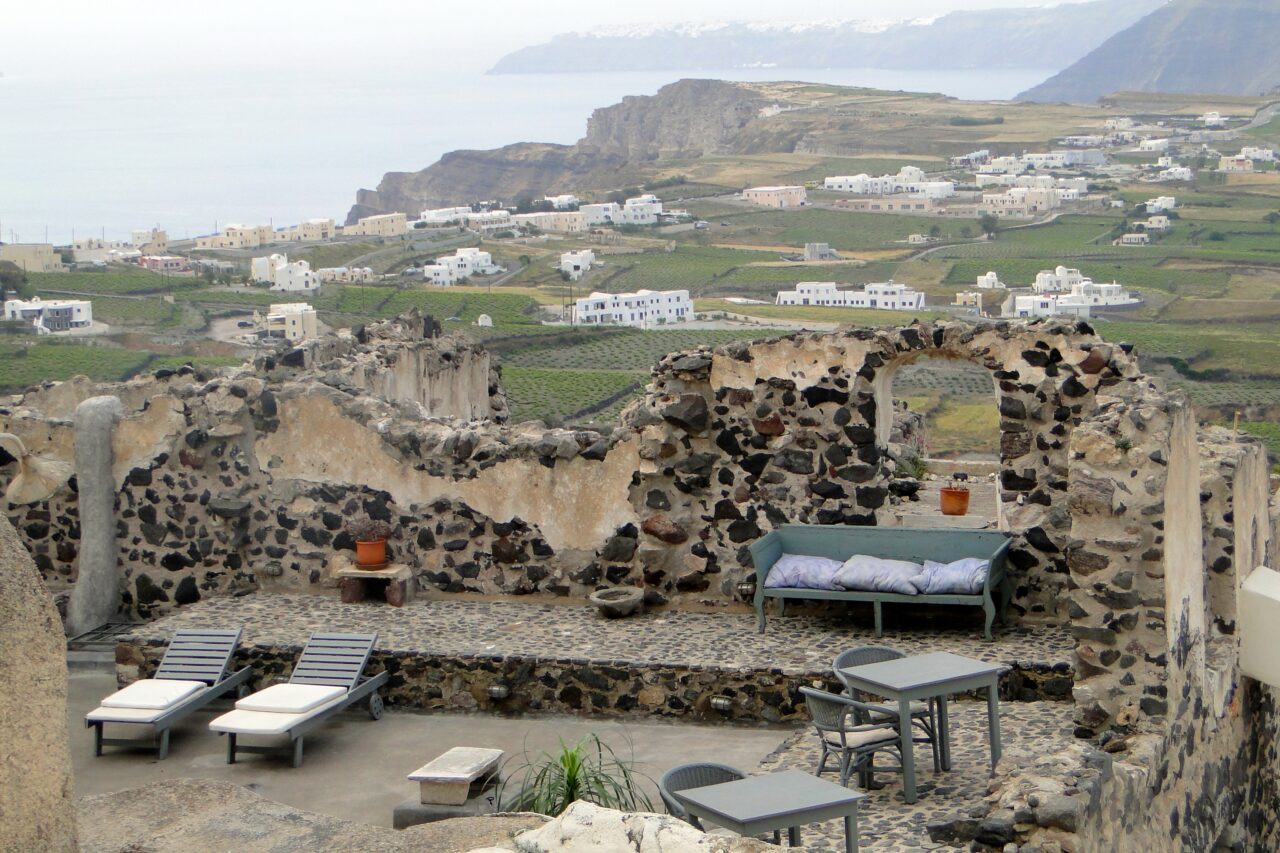
In 2014 Pyrgos was not on the tourist map having been bypassed by real estate, tourism development or even repairs from the earthquake. The dramatic cliff resorts and designer shopping in Fira eclipsed this thousand-year-old town. In my 2019 return I came to know a Santorini that’s more than just ultra-lux resorts and bespoke vacations.
As the island’s former capital, Pyrgos, just seven and half kilometers south of Fira, was strategically built in the heart of Santorini at the foot of Mt Profitis Ilias. Its charm is different thanks to civic minded entrepreneurs. The pace of life is more relaxed. The main square, with its tall pine trees and cafes, is the focal point for socializing.
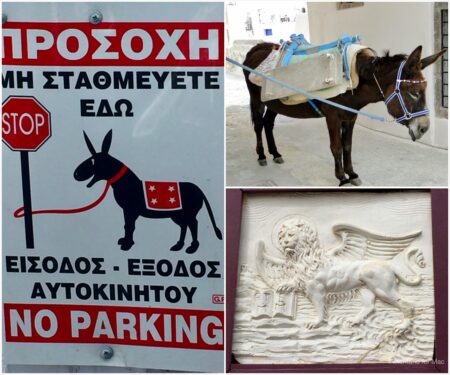
Pyrgos, a UNESCO World Heritage Site, is preserved as a traditional Cyclades Island village that happens to exist in the 21st century. Its steep narrow streets make the use of cars limited to the town’s perimeter. Slow walking up winding stair “streets” encourages looking at small details. After a long period of neglect, the jumble of old buildings is reemerging into a quiet yet lively village still crowned by Venetian fortress walls.
Driving and parking is only possible along a perimeter ring road around the base of the hill. Several high-end small hotels are located on this road as well as within Pyrgos. The pedestrian street network makes it possible to trip over discoveries in Pyrgos and return to your starting point.
The Cultural Village
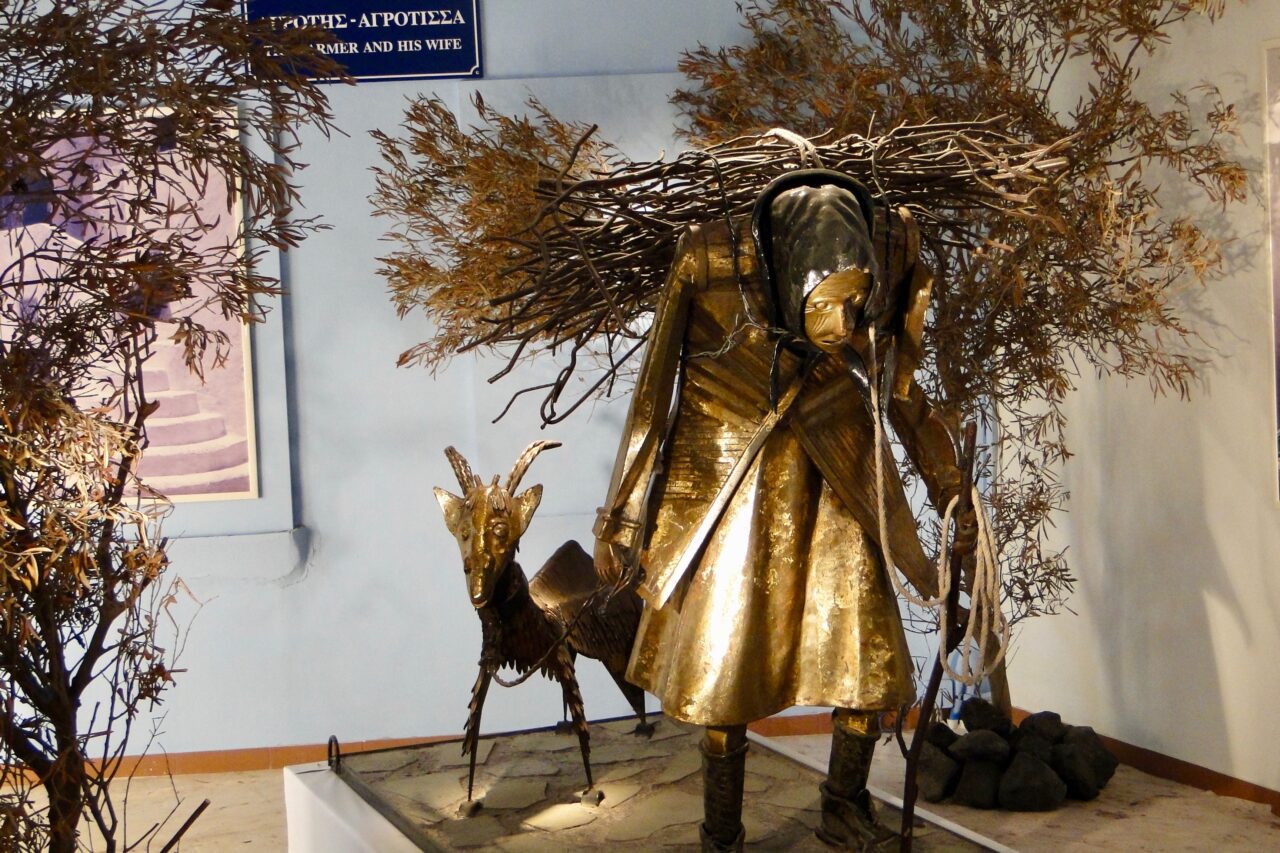
The Cultural Village is a mini neighborhood of restored buildings comprising a museum, hotel and commercial space close to the town square. Created over the past decade through private investment, it celebrates Santorini of the Past – everyday life and work, traditions, crafts and, especially, gastronomy. Through special events and workshops, the Village offers an integrated cultural and gastronomic experience to its visitors.

Santorini culinary history is a major segment of the exhibitions. “Santorini gastronomy post explosion was vegetable based,” says Georgia Tsara. The island was only repopulated in the 6th century A.D. – 4,000 years after the eruption. Cattle could not be raised. Eventually residents were able to maintain a few goats providing meat and milk and a pig, which was consumed nose to tail as well as using its fat – lard – for cooking since olive oil was unavailable. Even today, olive trees are just being introduced and most olive oil, as well as meat, is brought in from other islands and the mainland. Birds and rabbits did exist providing wild game for the diet, but even fishing was difficult because of the rough deep water.
Cultural House
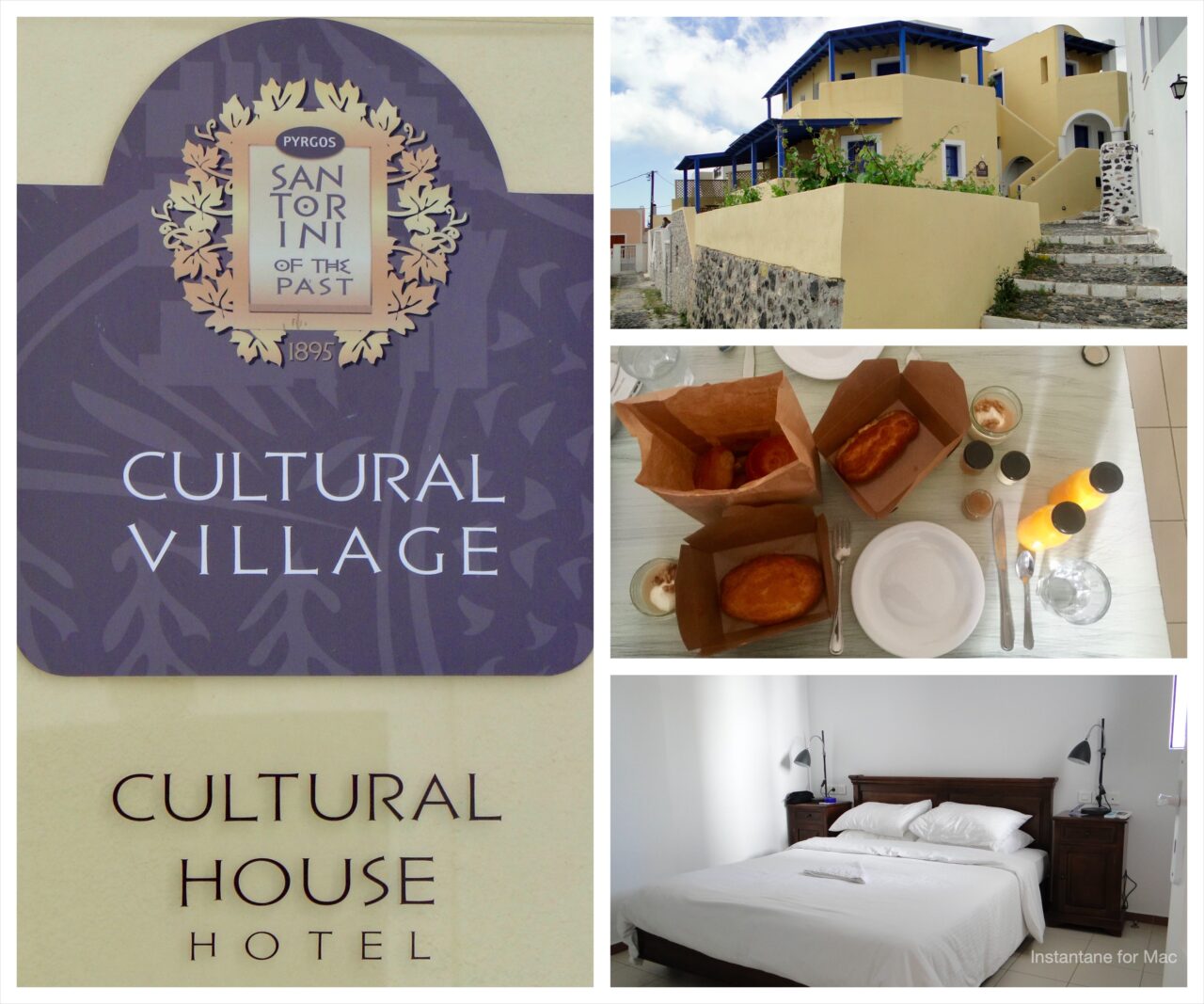
A stay at Cultural House within the Cultural Village is similar to living in a small apartment in a typical Pyrgos house with modern amenities. The apartment suites include spacious decks along with separate bedroom and sitting room/kitchen. An assortment of baked goods, juice, fruit, yogurt and beverage is delivered each morning at the time of your choice.
The staff double as advisors on what and how to experience Pyrgos and the surrounding area. The Cultural House is a very brief walk to the main square, the hub for bus and taxi transportation. All of Pyrgos is just footsteps from your room.
The Venetian Fortress

Venice was a major political and economic force in the Medieval Aegean world 12th – 16th centuries. It vied for power with the Byzantine and Ottoman Empires as well as with pirates. Like most islands of its time, Santorini fortified its capital, Pyrgos, with a substantial stone castle.

While wandering up the labyrinth of narrow streets a number of tiny shops and attractive cafes will extend your walk. Much of Pyrgos had to be slowly restored after the devastating 1956 earthquake creating a romantic city scape juxtaposing restored and remnants of ruins. Built on the highest point of the island, nearly 600 metres (1,900 feet) above sea level, a walk around the tranquil castle ruins offers many panoramic photo opportunities of the entire island of Santorini.
Cava Alta
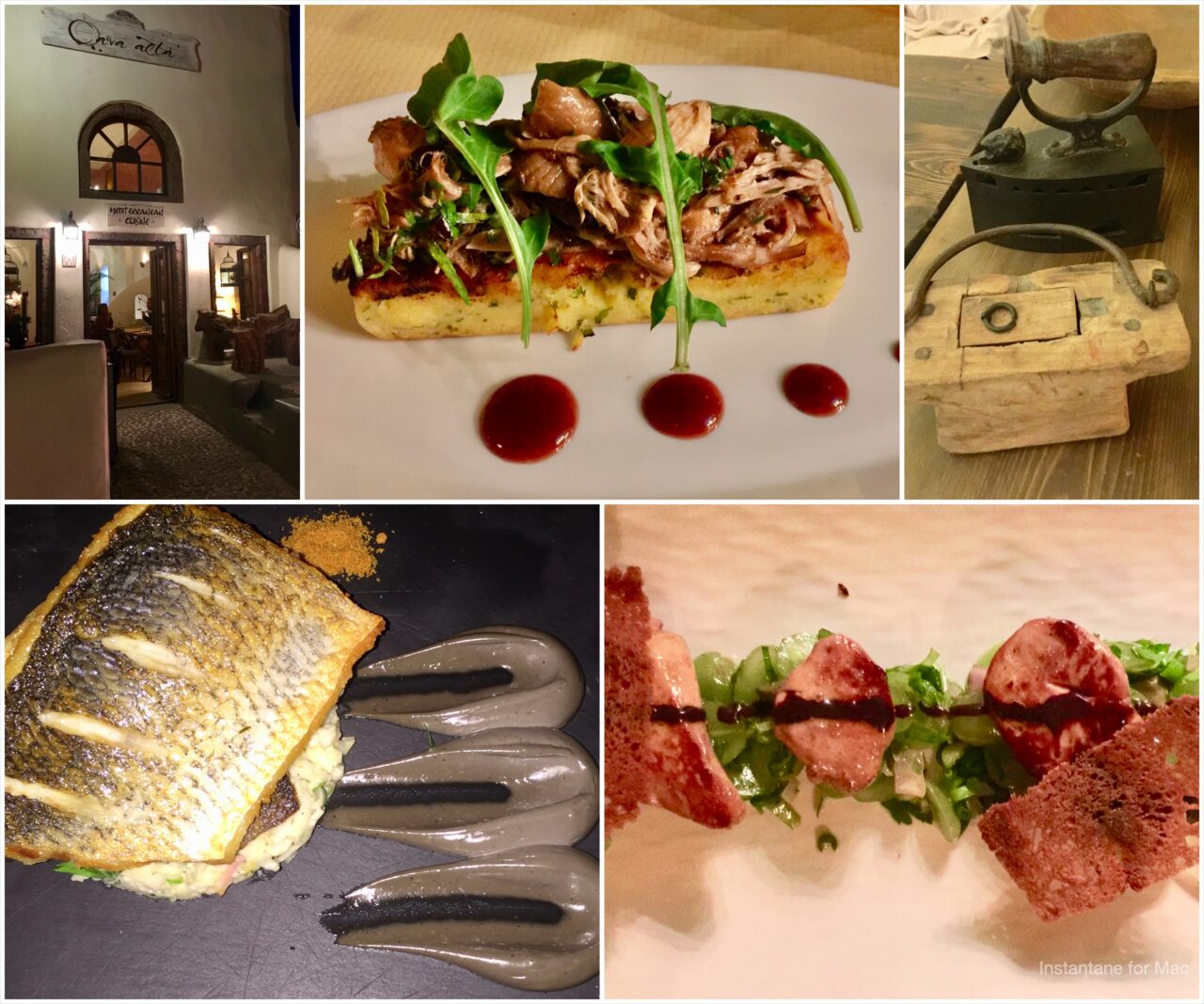
An architectural feature of Santorini has been the extensive use of carved caves for building use. The geology allows for both an abundance of natural and man-made caves and more than one structure from village home, to church to luxury hotel incorporate caves. Caves provide insulation and sturdy construction features.
In the case of Cava Alta it enhances the ambiance created by the art and antique collection that decorates the interior. The cuisine is an imaginative fusion of Mediterranean influences using locally sourced ingredients. The presentations are as artistic as the restaurant’s ambiance.
Selene (formerly Selene Restaurant and Selene Meze & Wine)

International award winning restaurant Selene relocated to Fira from Pyrgos in 2020 but continues to be an essential influence in Santorini gastronomy promoting the island’s unique foods and wines for 35 years. Owners Yiorgos and Evelyn Hatziyannakis and sommelier and Santorini gastronomy expert Georgia Tsara have been integral in the revival of Pyrgos. The original restored buildings anchored early development of the Cultural Village.
Selene opened in 1986 in Fira just as Santorini was repopulating from the 1956 earthquake. From the start it worked with local farmers promoting Santorini products but with a menu that tweaked tradition. Eventually they relocated to Pyrgos creating two restaurants, Selene and Selene Meze & Wine within a complex of restored Pyrgos structures that would become the center of the Cultural Village.
Dining in either were destination meals in 2014 and 2019. The menu changes frequently with dishes ranging from a wreath of pigeon, herb smoked seafood, sea bass ceviche with watermelon and raki, selections of artisan cheeses to a small faux Santorini White Eggplant that’s actually a molecular ice dessert. Their knowledge of wines is internationally recognized and following their recommendations is advised.
Santo Wines Oenotourism Center (Santo Wines and Union of Santorini Cooperatives)

Founded in 1947 after the devastating effects of war on Greek agricultural production, the Santo brand means more than wine. The Union of Santorini Cooperatives is the largest farm co-op on the island with approximately 2,500 members as well as its biggest wine producer.
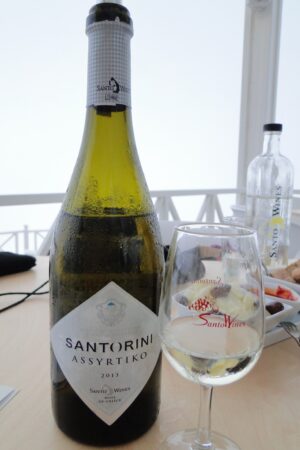
“Our main concern is the continuous improvement of quality,” Stela Kasiola insists. Research and development is carried out in the cooperative’s nursery so that Santorini vineyards remain true to the native varietals and maintain traditional organic cultivation methods. The unique Santorini fava bean, the main ingredient in one of Greece’s most famous mezedaes, and the intensely flavored Santorini tomato are as precious as the island’s indigenous 3,500-year-old assyrtiko and marvrotragano grapes.

The Oenotourism Center serves as an information hub on the island’s unique agricultural products. Wine tastings are always available, and the shop features all Santorini products. A pleasant indoor cafe in the modern glass walled room spills out onto a spacious cliff side terrace providing commanding views of the harbor and the volcanic caldera below.
Wandering the steep narrow streets of historic Pyrgos past medieval walls and restored townhouses, roosters crowed and the panorama of this storied island was always in view. It defined the continuum of Greece – millenniums of civilization bound tight by community and food.
When you go: Santorini is well connected by air to the Greek mainland, several islands and internationally. Ferry service from the Athens port of Piraeus is frequent with connections from other Aegean Islands.
Travel with Pen and Palate every month to Greece and the world in the Hellenic News of America.








